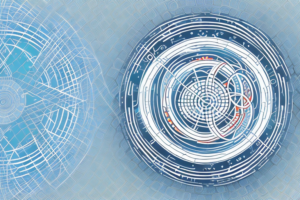What is NIST SP 800-37 Risk Management Framework?
8 min read
A layered diagram of the nist sp 800-37 risk management framework
The NIST SP 800-37 Risk Management Framework (RMF) is a comprehensive, structured approach to managing risks that are associated with the operation and use of federal information systems. The framework was developed by the National Institute of Standards and Technology (NIST) in response to the increasing need for cybersecurity solutions that can address the evolving challenges faced by federal agencies.
Understanding the Basics of NIST SP 800-37 Risk Management Framework
The NIST SP 800-37 RMF is a risk-based approach to cybersecurity that involves identifying, assessing, and prioritizing risks to information security and implementing mitigation strategies to reduce those risks to an acceptable level. The framework also emphasizes on continuous monitoring and ongoing assessment of cybersecurity risks to ensure that they are effectively managed over time.
One of the key benefits of using the NIST SP 800-37 RMF is that it provides a standardized approach to managing cybersecurity risks. This means that organizations can use the framework to ensure that they are following best practices and industry standards when it comes to cybersecurity. Additionally, the framework is flexible enough to be adapted to different types of organizations and their unique cybersecurity needs.
Another important aspect of the NIST SP 800-37 RMF is that it emphasizes the importance of collaboration and communication between different stakeholders within an organization. This includes IT professionals, security personnel, and business leaders. By working together, these stakeholders can ensure that cybersecurity risks are effectively managed and that the organization is able to respond quickly and effectively to any security incidents that may occur.
The History and Evolution of NIST SP 800-37 Risk Management Framework
The NIST SP 800-37 RMF can trace its origins back to the late 1990s when the US Federal Government began to recognize the need for cybersecurity standards and guidelines. Over the years, the framework has evolved, and new revisions have been released to address the changing cybersecurity landscape. The latest version of the framework, released in 2018, incorporates changes to keep pace with industry progress in cybersecurity.
One of the major changes in the 2018 version of the NIST SP 800-37 RMF is the incorporation of the Cybersecurity Framework (CSF). The CSF provides a common language and methodology for managing and reducing cybersecurity risk. By integrating the CSF into the RMF, organizations can better align their cybersecurity efforts with their overall business objectives.
Another significant change in the 2018 version of the framework is the emphasis on continuous monitoring and assessment. This approach recognizes that cybersecurity threats are constantly evolving, and organizations need to be vigilant in their efforts to detect and respond to these threats. By implementing continuous monitoring and assessment, organizations can identify vulnerabilities and risks in real-time, and take proactive steps to mitigate them before they can be exploited.
The Core Components of NIST SP 800-37 Risk Management Framework Explained
The NIST SP 800-37 RMF consists of six core components, which are:
- Step 1: Categorize Information Systems
- Step 2: Select Security Controls
- Step 3: Implement Security Controls
- Step 4: Assess Security Controls
- Step 5: Authorize Information System
- Step 6: Monitor Security Controls
These components, when implemented correctly, help ensure that risks to information security are effectively identified, assessed, and mitigated.
Step 1 of the NIST SP 800-37 RMF involves categorizing information systems based on their security requirements. This step helps organizations to identify the types of security controls that are necessary to protect their information systems.
Step 2 involves selecting security controls that are appropriate for the information system being protected. This step requires organizations to consider the security requirements of their information systems and select controls that are effective in mitigating identified risks.
Why NIST SP 800-37 Risk Management Framework is Important for Your Business
The NIST SP 800-37 RMF is important for any organization that operates critical infrastructure, handles sensitive information or uses federal information systems. The framework provides a common language for managing risks and ensures that cybersecurity is integrated throughout an organization’s operations, management, and technology processes.
Furthermore, implementing the NIST SP 800-37 RMF can help organizations comply with various regulatory requirements, such as HIPAA, PCI DSS, and FISMA. By following the framework, businesses can demonstrate their commitment to protecting sensitive information and reducing the risk of cyber attacks. Additionally, the RMF provides a structured approach to risk management, which can help organizations identify and prioritize potential threats and vulnerabilities, and develop effective mitigation strategies.
How to Implement NIST SP 800-37 Risk Management Framework in Your Organization
To implement the NIST SP 800-37 RMF effectively, an organization needs to have a clear understanding of its information security posture, identify its risks, and prioritize them. The organization can then select and implement appropriate security controls to mitigate these risks and continuously monitor their effectiveness. Implementation of the framework also requires buy-in and support from all levels of an organization, including management, IT, and other stakeholders.
It is important to note that the NIST SP 800-37 RMF is not a one-time process, but rather a continuous cycle of risk management. This means that organizations must regularly reassess their security posture, identify new risks, and adjust their security controls accordingly. Additionally, organizations should document their RMF processes and procedures to ensure consistency and accountability. By following these best practices, organizations can effectively implement the NIST SP 800-37 RMF and improve their overall information security posture.
Common Challenges in Implementing NIST SP 800-37 Risk Management Framework and How to Overcome Them
One of the most significant challenges in implementing the NIST SP 800-37 RMF is the complexity of the framework and the lack of resources and expertise to effectively implement it. Organizations can overcome these challenges by leveraging resources such as cybersecurity service providers, automation tools and training programs to support their implementation efforts. It is also crucial to ensure that all stakeholders are adequately informed and engaged in the implementation process.
Another challenge in implementing the NIST SP 800-37 RMF is the need for continuous monitoring and updating of the risk management plan. This requires a dedicated team and resources to regularly assess and update the risk management plan based on changes in the organization’s environment and threat landscape. Organizations can overcome this challenge by establishing a risk management program office and implementing a continuous monitoring process that includes regular risk assessments, vulnerability scans, and penetration testing. By doing so, organizations can ensure that their risk management plan remains effective and up-to-date.
Best Practices for Successful Implementation of NIST SP 800-37 Risk Management Framework
Some best practices to ensure successful implementation of the NIST SP 800-37 RMF include establishing a risk management governance structure, developing clear policies and procedures, integrating security into the organization’s culture and ongoing training and awareness programs for all employees in the organization.
Another important best practice for successful implementation of the NIST SP 800-37 RMF is to regularly review and update the risk management plan. This includes identifying new threats and vulnerabilities, assessing the effectiveness of current controls, and making necessary adjustments to the risk management framework. It is also important to involve all stakeholders in the review process, including senior management, IT staff, and business units, to ensure that the risk management plan remains relevant and effective.
Compliance Requirements and Regulatory Standards Related to NIST SP 800-37 Risk Management Framework
Many regulatory standards and compliance requirements are related to the NIST SP 800-37 RMF. The US Federal Government mandates the use of the NIST SP 800-37 RMF for all federal Information systems, and other organizations that have federal contracts or operate critical infrastructure may also be subject to compliance obligations.
In addition to federal compliance obligations, many industries have their own regulatory standards related to risk management. For example, the healthcare industry is subject to the Health Insurance Portability and Accountability Act (HIPAA), which requires organizations to implement a risk management program to protect patient data.
Furthermore, international organizations may also have compliance requirements related to risk management. The European Union’s General Data Protection Regulation (GDPR) mandates that organizations implement appropriate technical and organizational measures to ensure the security of personal data.
How to Achieve Compliance with NIST SP 800-37 Risk Management Framework
The best way to achieve compliance with the NIST SP 800-37 RMF is to follow the framework’s guidelines fully. This includes implementing all six core components, maintaining and monitoring security controls, and undergoing regular risk assessments and authorizations. Organizations should also document all processes and procedures to demonstrate compliance if audited.
It is important to note that achieving compliance with NIST SP 800-37 RMF is an ongoing process and not a one-time event. Organizations must continuously assess and manage risks to maintain compliance. This includes staying up-to-date with the latest security threats and vulnerabilities, implementing new security controls as needed, and regularly reviewing and updating policies and procedures. By prioritizing compliance and making it a part of the organization’s culture, organizations can ensure the security of their systems and data.
The Benefits of Implementing NIST SP 800-37 Risk Management Framework for Your Business
The benefits of implementing the NIST SP 800-37 RMF for your business include improving the overall security posture of your organization, reducing the likelihood of cybersecurity breaches, increasing confidence among stakeholders in the security of the organization’s operations, and demonstrating compliance with regulatory standards and requirements.
Another benefit of implementing the NIST SP 800-37 RMF is that it provides a structured approach to risk management, which can help organizations identify and prioritize risks more effectively. This can lead to more efficient allocation of resources and a more targeted approach to risk mitigation.
In addition, implementing the NIST SP 800-37 RMF can help organizations stay up-to-date with the latest cybersecurity best practices and standards. The framework is regularly updated to reflect changes in the threat landscape and emerging technologies, so organizations that adopt it can be confident that they are using the most current and effective risk management strategies.
Real-life Examples of Successful Implementation of NIST SP 800-37 Risk Management Framework
There are many examples of successful implementation of the NIST SP 800-37 RMF. The US federal government is one such example, where all federal Information systems must follow the framework’s guidelines. Other organizations that have implemented the framework successfully include financial institutions, healthcare providers, and defense contractors.
In conclusion, the NIST SP 800-37 RMF is a comprehensive framework for managing risks associated with federal information systems. The core components of the framework, when implemented effectively, can help an organization effectively identify, assess, and manage risks to information security. While implementing the framework comes with its challenges, the benefits of doing so are numerous, including improved security posture, increased compliance, and mitigated risks.
One example of a successful implementation of the NIST SP 800-37 RMF is the US Department of Defense (DoD). The DoD has implemented the framework across all of its information systems, resulting in improved security and compliance. Another example is the National Aeronautics and Space Administration (NASA), which has used the framework to manage risks associated with its space exploration missions.
It is important to note that the NIST SP 800-37 RMF is not just limited to federal information systems. Private sector organizations can also benefit from implementing the framework. For example, a large financial institution implemented the framework to manage risks associated with its online banking platform, resulting in improved security and customer trust.



